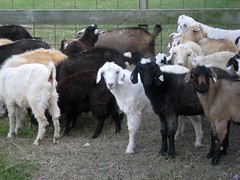A study recently published in the American Sheep Industry Association's Sheep & Goat Research Journal showed that it may be beneficial to finish meat goats over a longer duration, so long as labor costs are not counted.
Researchers at Tennessee State University assigned 30 weaned F1 crossbred does to three different finishing periods: 45, 90, and 135 days. The does were fed a commercial finisher ration daily, but the total amount of ration that was consumed by the groups of goats over the duration of their feeding period did not differ. At the same time, the goats were continuously grazed on chicory. At the end of the finishing period, the goats were harvested to collect carcass data.
Average daily gain was highest for the goats fed for 45 days. It decreased linearly with an increase in the length of the finishing period, but feed efficiency improved the longer the goats were fed. Though not statistically different, there was a tendency for slaughter weight to increase with feeding duration.
While feed costs did not vary among the groups, cost per gain was lowest for the goats fed for a longer period of time. The longer finishing period also returned more dollars (above feed costs). However, the economic advantage of the longer feeding period would be negated if labor had to be paid or labor costs were included in the profit calculation.
Dressing percentages increased with the length of the feeding period. The weight of boneless-retail cuts from the leg, loin, rack, and shoulder tended to increase with a longer feeding period. Back fat thickness and carcass fat cover did not vary among goats from the three groups, but kidney and heart fat was highest for the 45-day period, suggesting that goats fed on a high plane of nutrition for a short period of time may deposit the excess energy as fat.
Source: Sheep & Goat Research Journal, Volume 25, 2010.
Read full journal article
Researchers at Tennessee State University assigned 30 weaned F1 crossbred does to three different finishing periods: 45, 90, and 135 days. The does were fed a commercial finisher ration daily, but the total amount of ration that was consumed by the groups of goats over the duration of their feeding period did not differ. At the same time, the goats were continuously grazed on chicory. At the end of the finishing period, the goats were harvested to collect carcass data.
 |
| Crossbred does |
While feed costs did not vary among the groups, cost per gain was lowest for the goats fed for a longer period of time. The longer finishing period also returned more dollars (above feed costs). However, the economic advantage of the longer feeding period would be negated if labor had to be paid or labor costs were included in the profit calculation.
Dressing percentages increased with the length of the feeding period. The weight of boneless-retail cuts from the leg, loin, rack, and shoulder tended to increase with a longer feeding period. Back fat thickness and carcass fat cover did not vary among goats from the three groups, but kidney and heart fat was highest for the 45-day period, suggesting that goats fed on a high plane of nutrition for a short period of time may deposit the excess energy as fat.
Source: Sheep & Goat Research Journal, Volume 25, 2010.
Read full journal article

No comments:
Post a Comment